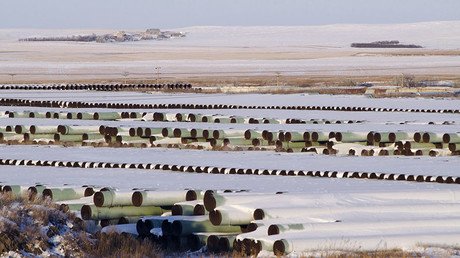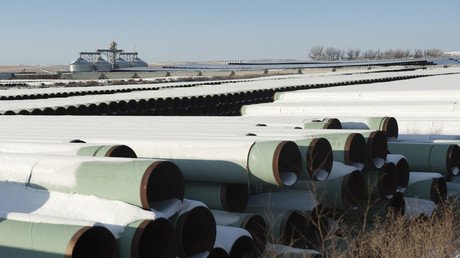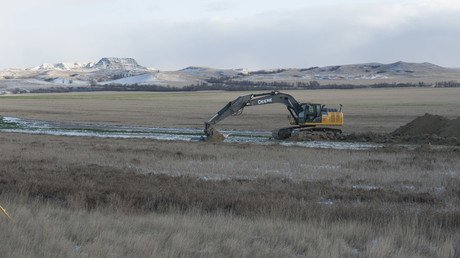N Dakota pulls water tanks from pipeline protest site as judge urges compromise

North Dakota authorities have removed drinking water tanks from a camp central to protests over the Dakota Access Pipeline. Positioned upstream from tribal land, the pipeline will threaten sacred indigenous sites and drinking-water sources, opponents say.
With temperatures at the campsite reaching around 90 degrees Fahrenheit, North Dakota's homeland security director had the tanks and state-owned, air conditioned trailers removed from the protest site, near the confluence of the Cannonball and Missouri Rivers, on Monday.
The items had been delivered a week ago by the state Department of Health at the request of the Standing Rock Sioux Tribe, which has led opposition to construction of the 1,172-mile long pipeline that would stretch from North Dakota to Illinois and cross underneath the Missouri River, which provides water to the tribe’s 8,500-strong community, according to the Standing Rock Sioux Tribe Department of Water Resources.
Fighting to protect their water! Then the government takes away their drinking water at the protest. #NoDAPLpic.twitter.com/iW4IPxf4NB
— George Bear Claw (@GeorgeBearClaw) August 23, 2016
Officials said that alleged reports of illegal activity surrounding the protest site, including the use of lasers pointed at pilots monitoring the campsite, was the impetus for their actions. In the last two weeks, 29 people have been arrested at the campsite, the tribal chairman included, for blocking entry to construction sites. Two incidents of alleged use of laser pointers aimed at aircraft flying over the campsite are being investigated by authorities. One pilot claimed to be blinded temporarily, according to the Morton County Sheriff's Department.
"Based on the scenario down there, we don't believe that equipment is secure," Homeland Security Division Director Greg Wilz said, according to the Forum News Service.
Evacuation drills for the children were conducted at #NoDapl camp. In case the soldiers come. pic.twitter.com/bQ1S0CCRsB
— Black Buffalo Woman (@RedRoadWoman) August 23, 2016
Protesters had complained that the aircraft were used to destabilize cell phone service, though Morton County Sheriff Kyle Kirchmeier disputed that assertion, saying the planes are used for public safety purposes.
North Dakota Governor Jack Dalrymple also reached out to federal officials for help managing the growing protests, which have reached between 2,000 and 4,000 people, according to reports.
The Comanche came. The Kiowa too. This is historic and unprecedented. #NoDAPLpic.twitter.com/D0reQt1l6O
— Black Buffalo Woman (@RedRoadWoman) August 21, 2016
"I've been getting notifications from tribes all over the country that have caravans in route, so it's continuing to grow," Standing Rock spokesman Steven Sitting Bear told Forum News Service.
Three Affiliated Tribes joins support for pipeline protest https://t.co/onMzCMhbqLpic.twitter.com/tzveK8JFbR
— The Bismarck Tribune (@bistrib) August 23, 2016
On Friday, Dalrymple issued an emergency declaration that freed state resources to manage the protests, which are centered on land owned by the US Army Corps of Engineers.
words will never articulate the beauty that is this moment. nations uniting.praying.laughing..together #dakotaaccesspic.twitter.com/ljQkBO3PSR
— Shailene Woodley (@shailenewoodley) August 22, 2016
Corps spokeswoman Eileen Williamson said it is monitoring the campsite, but no particular action is in the works.
"At this point, there is not a permit, but it is my understanding they are requesting a permit," she said of the protests, according to Forum News Service. She added that while permitless protesters can be ticketed by the Corps, only law enforcement are authorized to remove them.
"We want to make sure that things are handled peaceably," she said.
Legal action
Work on the contentious $3.7 billion pipeline is temporarily on pause. On August 10, Standing Rock filed an emergency injunction in an attempt to delay construction long enough for their concerns to be heard. Chief among them are the potential to contaminate the tribe’s main drinking source and their potential responsibility for cleaning up toxic spills that could seep into their land.
The tribe has been protesting the construction for months by holding prayer-ins near construction. However, the situation escalated in mid-August when a dozen protesters were arrested for coming too close to construction. Last week, Dakotas Access LLC, the pipeline's developer, confirmed that it would press charges against the protesters and seek to file restraining orders against them in order to block opposition from the site. Standing Rock Sioux leaders are being represented by former North Dakota US Attorney Tim Purdon.
The company also agreed to halt construction until its case could be heard in federal court. On Monday, a federal judge postponed a hearing that would have determined whether protesters could be blocked from the protest site.
"The parties are strongly encouraged to meet and confer in good faith in an attempt to resolve this dispute prior to the hearing," the judge wrote, according to the Wall Street Journal.
Energy Transfer Partners LP, the builders of the pipeline, has continued construction at other points on the planned route. The pipeline would be a major carrier of crude oil from North Dakota's Bakken Shale formation to the Midwest and down to the Gulf of Mexico, leading some to see it as Keystone XL 2.0, named after the Canada-to-Texas tar sands pipeline that was eventually blocked by the Obama administration.
A coalition of indigenous groups in opposition to the pipeline called Tuesday for more attention from human rights groups to defend their position.
More tribes are formally supporting the protest of construction of the Dakota Access Pipeline https://t.co/6tHLtcJ4Qb
— Des Moines Register (@DMRegister) August 23, 2016
The pipeline "threatens the ancestral sites that are significant to our tribe. And we never had an opportunity to express our concerns," Dave Archambault, chair of the Standing Rock Sioux Tribe, told Democracy Now.
"This is a corporation that is coming forward and just bulldozing through without any concern for tribes. And the things that have happened to tribal nations across this nation have been unjust and unfair, and this has come to a point where we can no longer pay the costs for this nation’s well-being."















